Paul's blog
Not the recommended method for celebrating your 50th!!!
Two days ago we completed Run number 48, 49... and most of run 50.
Run 48 was done with the main rudder up but I struggled to turn VESTAS SAILROCKET away from the shore and passed very close to the beach before regaining control. So close in fact that I passed between the RIB and the timing hut... at over 42 knots of boat speed. I had the wing angle set out at around 20 degrees and figured that this contributed to the boats reluctance to bear away. At this stage I also believed that I was using the full range of the skeg steering. When you are fighting to avoid both the RIB and the shore at such high speeds you don't have time to look at the instruments... we will do that later when we consult the PI RESEARCH data logger. Another noticeable factor was the pod as this was flying cleanly throughout the top speed phase. Not skipping or even bouncing... but flying.
It was a glamorous day so we returned to the top of a very sunny 'speed-spot' for run 49. I was figuring on sheeting in the wing to a tighter angle and leaving the big rudder down just as a safety. This run went very smoothly and VESTAS SAILROCKET virtually sailed herself down the course with very little input from me. We peaked a fraction of a knot under 40 but completed a very smooth run with neutral helm.
The wind had picked up a little and we still had some time left. Should I tempt fate and do our 50th run down the Walvis Bay speed course? Absolutely. This game is not about being shy. I was determined to do a big run and see a new high peak speed to celebrate surviving to our 50th run. I sheeted in to around 10 degrees as VESTAS SAILROCKET accelerated like a... like a rocket I guess! The lee helm began very quickly. I eased the wing a little to lessen it but we were already well over 30 knots and I couldn't turn the bow up onto the course... even with the foot steering and the large low speed rudder. We were away from the flat water along the shore and out in the rough. I held it for a little while and then decided to bail out. The ride got bumpy. I heard that horrible noise of crisp composites failing. I figured that it might be the aft planing surface and focused on stopping the ride. Then all the steering went limp. Nothing! Something serious had happened. The boat swung wildly into a round-up and we were about to confront our old nemesis. The wing was now king and I was a spectator. It backwinded and sure enough... collapsed the beam. The beam folded to 90 degrees as VESTAS SAILROCKET effectively tacked to be pointing a full 180 degrees to course. The wind got under the back side of the wing and the whole show blew over. We had capsized. I was out of the cockpit and slid over to the bottom of the cockpit as if I was tipping a small beach dinghy over.
Helena and Hiskia were quickly on the scene and we managed to secure the scene by making sure all the data loggers were safe and that all the components were with us so that we could look into the cause later. I have been in this position enough times to know that we have to be very careful. The damage may not be as bad as it seems and we could easily make it a lot worse by doing the wrong things after the event. We nursed our crumpled boat back to the shore and began sorting it out. As we inspected the pieces the chain of events became obvious. It took us a few hours to get everything safe. The tide was very low so for the first time we had to leave our poor broken, wet and sandy boat over on the course along with the wing. We returned well after dark to an empty operations base on a near to moonless night.
I didn't sleep very well but with the new day comes the new challenge. We waited for the tide to come in and went and retrieved all the pieces. It really isn't that bad. The wing has once again amazed us by it's ability to resist major damage. the beam is simply broken in the same spot it always breaks. I'm good at repairing that part now. there is no point in making that area stronger. Something has to break in that situation. All the damage is very localised. There are broken bits literally from the top of the mast to the very back of the boat... but we have sustained worse.
I don't feel that bad about what happened because we didn't do anything wrong or build anything badly. A whole rudder bracket had simply been torn of the transom of the boat in a manner we hadn't figured on. It must have taken immense force. Much more than was ever accounted for.
It was akin to a Tyre blow-out on a race car that leads to an accident. The tyre is at fault and not the car.
The fixed skeg is locked off against these rudder brackets so once the rudder was gone... the skeg was no longer fixed. We effectively lost the 'tail of the aero plane'. When we rebuild it there will be a complete redundant system. All the data from the skeg, wing and wind was recorded as was the onboard footage which clearly shows the chain of events. Of course we aren't happy to be fixing the boat instead of sailing it but then this aspect of our project is just as much a part of the project as the more successful times. Each time we come back smarter and better prepared to move forward.
We will take around two weeks to get VESTAS SAILROCKET back in fighting shape.
In that time we will go over all aspects of what happened and what needs to be changed.
I'm already looking forward to Run 51 (it's my old motorbike racing number).
Cheers, Paul
Low tide down time until Sunday
The high tides have now moved into the late evening leaving us with low water in the afternoon. So no sailing I'm afraid. We haven't missed out on any wind as the coming of the low afternoon tides also seems to affect the afternoon breeze. This has happened a couple of times now so we will watch it in the future to see if it is just coincidence or a reliable relationship. Having said that, the wind has returned this afternoon.
Boating projects are affected by two tides, one involving the water and the other involving the job list! It is the latter that we are still doing battle with. I have been focusing on areas beneath the water over the last two days. The silicon seal around the main foil has been replaced, the rudder sensor has been relocated from the large low-speed rudder to the skeg flap (seeing that we will now be steering with that at high speed) and I have extended the anti-ventilation fence on the skeg all the way to the back so that it envelopes the skeg flap. This is the area most likely to ventilate so it is worth the effort. Making an airtight articulated fence took alot of thought. I had a chair positioned at the back of the boat and I just sat there and stared at it for hours until the build process was clear in my mind. I think that the final result will be quite elegant and hopefully quite effective.
On that last run, Run 46, I was using the full range of the skeg to hold VESTAS SAILROCKET up on course. Based on 'Malcs Calcs' this should have resulted in quite a lot of turning force. We can only guess that the skeg flap had ventilated. As mentioned previously we can also do a number of things to balance the boat out at high speed so the steering loads are lighter and we have in fact already done that. The extended fence is just extra security.
The support RIB is outside getting a complete steering system overhaul and general service. Things were getting tight and although we pull it out of the water for a washdown on a regular basis... we do sometimes forget we are a multiple boat family that definitely has its favourite sibling! Support boats need love too.
Helena is constantly improving the electronics package and keeping my head screwed on right:)
So all is well as we prepare for our next session of afternoon high tides and belting winds. I can feel the pressure mounting to go out and pull off a big run.
Cheers from the container at Walvis Bay Yacht Club,
Paul
A GORGEOUS DAY WITH TWO MORE 40+ KNOT RUNS POSTED...BUT...!!!
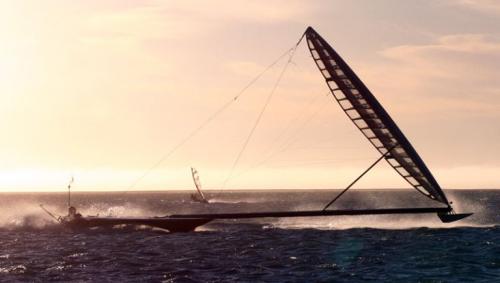
Yesterday was one of the best days I have seen over at the Walvis Bay 'Speed-spot'.
The water was a beautiful blue as was the sky and the wind was pumping in at around 20 knots with higher gusts. We weaved VESTAS SAILROCKET through the ever increasing fleet of Hobie cats present on the lawn of the Walvis Bay Yacht Club and made our way across the lagoon. As ever I was keen to make a big run and continue our climb up the numbers. Rough rides in bumpy water with the large rudder down are no longer acceptable. The last two runs were both done with the large low speed rudder up and it felt great. Today I would test the effectiveness of the hand steering/skeg flap at speeds over 40 knots. New guy Klaus would be our fifth man.
The first run went well. I sailed in nice and tight and had a relatively smooth ride. This had the double benefit of keeping the spray down. I used the hand steering for the whole 500 meter course and it seemed quite effective. The low speed rudder failed to kick up due to... and I'll be honest... user error on my part. In the long list of checks I do in between dropping the tether at the start and actually turning VESTAS SAILROCKET onto the course and accelerating, I hadn't released the rudder pull-down line and this held the rudder down after I released the 'up' trigger. By the time I realised we were already approaching 40 knots. A mistake on my part but it didn't involve any risk.
So we hit a peak speed of 42.3 knots. The wing was sheeted to only 20 degrees throughout this run. The reason for this was that I sheet in initially when both my hands are free as it is harder once one hand is being used for steering. For these first high speed runs using the hand steering I am concentrating very hard on this aspect and not so hard on the wing angle. It will all come with practice and familiarity. The wing flap sheeted on nicely and it all felt fine. Although VESTAS SAILROCKET responded well to the hand steering... it still didn't feel entirely precise. I was still weaving around a little.
RUN 45, MEAN WIND SPEED 18.5 KNOTS, TOP SPEED 42.5. WING ANGLE AT 20 DEGREES, WING FLAP ON, LARGE RUDDER STILL DOWN. USING HAND STEERING. POD VERY 'FLOATY'... AS IS FRONT END!
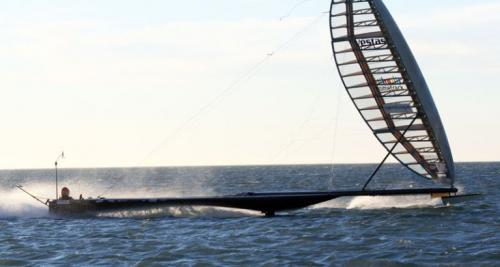
At the end of the run I was keen to get back up the course and try it again. The wind had built a little and I wanted a new top speed but more importantly... I wanted to nail a 42.5 knot average over the course. This is a performance milestone that we have set ourselves which we are now slightly overdue to achieve. I know we are more than capable and want to get it in our wake ASAP.
In my mind I was going to focus on sailing in tight, making sure the large rudder is kicked up and making sure that the wing was sheeted in harder before going to hand steering. Vestas SailRocket strained at the tether line as she swung her nose away from the beach in a long arc prior to release. She quickly powered over the 'hump' and up onto her planing surfaces whilst I began to bear away and line up the start of the course. This is always a sensitive part of the run as it is usually the phase where, if we are not careful a rounding up force can overpower the steering and send me into the beach. This time we were OK and I felt the reassuring force of leeward helm which signalled that all was well and VESTAS SAILROCKET was sailing as she was designed to do.
HEADING UP TO THE COURSE THROUGH THE START UP SEQUENCE FOR RUN 46.
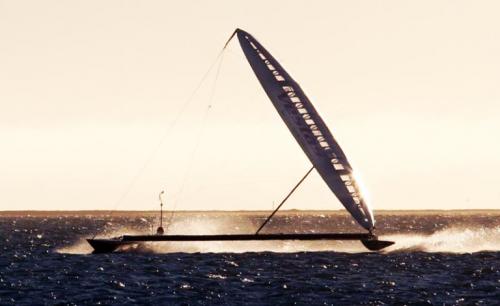
I sheeted the wing into 15 degrees and went to the hand steering. We were quickly up to 40 knots but I noticed I was using the full range of the skeg steering to hold the boat up onto the course. The aerodynamics were overpowering the hydrodynamics and the only way I could hold VESTAS SAILROCKET up onto the course was to put in a little bit of foot steering via the still deployed large rudder. This initiated a sharp turn to windward which is a little unsettling as it can instigate a high speed round-up. I was still at full forward lock on the hand steering so it was obvious that I couldn't kick up the big rudder. Visibility was good enough for me to be able to see the course. I held on for the full 500 meters and then brought the show to a stop.
The top speed was only slightly higher than the previous run but the run involved a lot more weaving. I wasn't happy. We should have done at least 45 knots in these conditions... and I mean at least. It was a perfect day.
So what happened? My first guess is that by sheeting in harder in slightly stronger winds on the second run, we simply had too much lee-helm i.e. the balance of the boat was making her want to turn away from the beach too hard. This can be quite quickly and easily compensated for in a number of ways. VESTAS SAILROCKET is a highly adjustable boat. We can either move the wing aft by swinging the beam or wing aft. This is done by simply adjusting the lashing lengths on the end of the fore and aft supporting cables. Another means of trim adjustment is to adjust the angle of the rear skeg to the main foil. This is done by a screw adjustment and is also quite simple. In all fairness, we can't expect our first stab at a high speed configuration to be exactly right and it will probably be something that we will be playing with until the end.
What does impress me about our current status is how smooth the whole operation is becoming. The overall, comfort, stress and functionality levels are all very good. We have the ability to just plug in a new team member and go and punch out consecutive 40 knot runs with little or no fuss. Although we still have many obstacles to overcome I really feel that we have emerged from our darkest days and that we are in great fighting shape. Our last big crash was on Run 23 and we have now doubled that amount of runs without incident.
I tried to go back for another run but as we got to the top of the course... the sun had made it to the horizon. We reluctantly packed up. I felt frustrated that we hadn't topped 44 knots at least but the fact is that we are always learning and in some cases it doesn't really matter if there is a tick or a cross in a certain box... as long as it answers a question that will show you the next direction you need to take.
CONCLUSION: Right now, at high speed in winds over 20 knots, the current boat configuration appears to be imbalanced to the point where the skeg steering cannot correct it. We need to reconfigure the boat. One good aspect is that VESTAS SAILROCKET is trying to turn away from the beach and hence danger in this setup. The visibility was improved in the cockpit by sailing in closer to the beach and hence in flatter water.
The data from the PI RESEARCH, B and G and TACKTICK loggers has all been downloaded and sent off to Malcolm. Both the onboard footage with pilot audio and the onshore footage with audio has been downloaded and co-ordinated with the PI RESEARCH data so that we can watch all the data and footage together on the computer in real time. It is a brilliant system that allows you to go back and really study the reality of a certain moment in time in intricate detail.
The weather does not look that favourable today as it is forecast to be quite light. In fact the rest of the week looks pretty average which means we will lose the remainder of this afternoon high tide. Things might change so we will stay on standby nonetheless. One of the main contenders for 50 knots, Hydroptere, is now back in the water and ready for sailing. She looks fantastic and I am eager to see what her new configuration will yield. Of course we want to beat her on the water and are doing all we can to do so. I am honestly glad that they are back and as hungry as ever to go faster. The competition is a healthy one.
Cheers, Paul
Runs 43-44. the wind comes, the wind goes... so do the spray deflectors!!!
We arose early this morning as the miraculous Mr 'M's time was up with us and we had to post him off to the airport. I finally got a great little boat builder down here at the Walvis bay 'coal-face'... and didn't break the boat once! Typical.
Helena and I returned to the slightly emptier container and pushed on with the joblist. Within an hour I was back in the mixing pots doing odd little jobs. We put the newly skinned wing back on Sailrocket and wheeled her into the hangar away from the UV rays. I gave the wing a thorough inspection and she seemed in pretty good shape considering the hard life we have given her to date.
Today marked three more months for us in Namibia on this latest trip. We were due to fly back but chose to stick around until we get some definitive results. We have now done 21 runs with no mishaps. Today was shaping up to be a great day. The newly logo'd Musto tops came back from Gino and the folks at DREAMWORLD in Walvis Bay... and we wear them with pride. The day looked great and we ran around all over the place looking for a good hand to replace Mr 'M' for the days sailing. In the end we were all standing around in drysuits... but couldn't go anywhere as we were too short staffed. As a last ditch effort I called a mate Gary who runs the best bar in town and he put me onto 'Sammy'... short for Samson. It was Samson's day off from running the bar and a couple of weeks earlier we drove a 2000 km round trip to go to Samson's traditional wedding way up in the North near Angola. We had his awesome smiling 'dial' in a drysuit in ten minutes... and we were off to 'speed-spot' once more.
The day just seemed to get better and better. I wanted to set a new best speed and a good 40+ average so that I could call Mr 'M' whilst he waited in the airport for his flight back to the UK. With this in mind I swung VESTAS SAILROCKET out onto the course for the 43rd time. As I rounded up onto the course I noted that she had adopted a rather nose down attitude and was stubbornly refusing to 'pop' up onto the plane. I tried all the tricks but she just mushed along. The spray deflector which hadn't hindered us on lighter days was now acting like a drogue. I had no option but to abandon the run somewhat disheartened. Our spray issues have not been resolved. Fortunately we had only stuck it on with Sika-Flex and I could cut it off with a piece of fine line.
VISIBLY NOSE DOWN ON RUN 43
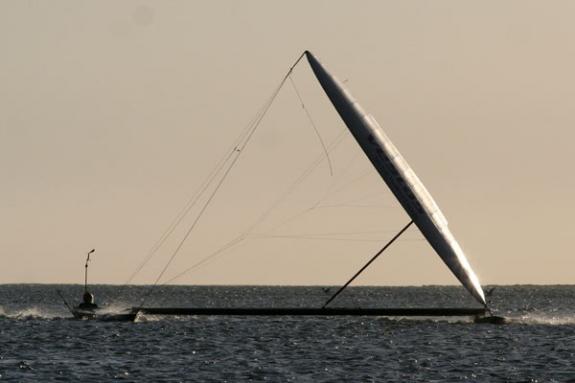
We took VESTAS SAILROCKET back up to the top of the course but as luck would have it... the wind was dying out. And die out it did. So run 44 went by in a low riding mode... so low in fact that I sailed the good ship all the way across the lagoon to the Yacht Club and parked it on the beach out front.
COMING INTO THE WALVIS BAY YACHT CLUB... PURE AFRICA
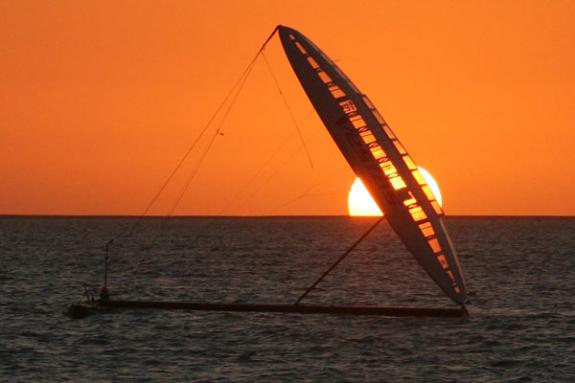
Ho-Hum. No joy there. We were a little late onto the water due to being a man down. We should be back up to strength as of Saturday when we will gain another local team member.
Overall the boat and team gets stronger by the day as the detail work gets attended to daily. The spray deflector did work... but it wasn't perfect. We still have it with us... but I will try some side skirts on the forward planing surface next... and a new forward planing surface after that. Let's see what tomorrow brings.
Cheers, Paul